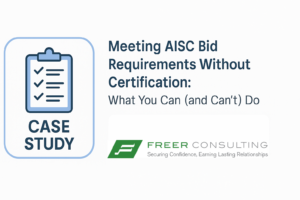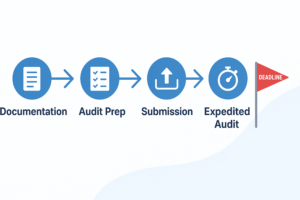In this time of social distancing due to the Covid-19 pandemic, it’s challenging to comply with regulatory requirements due to disruptions in business operations or lowered staff availability. Despite these challenges, there isn’t a legal mechanism that relieves businesses of their duty of regulatory compliance. The pandemic and efforts to fight it continue, yet rain will still fall and stormwater must continue to be managed to reduce pollutants entering our waters.
Many businesses have shifted, at least in the short term, to remote work wherever possible. There’s a number of business functions that you can do remotely, and stormwater regulatory compliance is among them. Some of the stormwater compliance requirements than can be met in a remote environment or a Covid-19-safe work environment include:
- Permit application and other documentation assistance (NOIs, NOTs, corrective actions, etc.).
- Stormwater plan (SWPPP) development, implementation and auditing.
- Sampling.
- Annual training.
- Consultation and implementation of best management practices (BMPs).
- Engineering planning and water treatment design.
- Electronic reporting and portal setup.
Permit applications
The EPA and many states have moved to online systems for submitting stormwater permit documents, such as Notices of Intent (NOIs) for stormwater permit coverage and Notices of Termination (NOTs). This allows for greater convenience and faster processing times, because you don’t need to print out, sign, and mail physical copies of stormwater documentation. What’s more, you can access it anywhere, which is really helpful if your employees are spread out over multiple locations and you need to collaborate on regulatory compliance.
SWPPP development
The central document for anyone who’s regulated under a stormwater discharge permit is the Storm Water Pollution Prevention Plan (SWPPP). The SWPPP is a significant requirement of any stormwater permit and it describes in detail how the permittee will comply with the requirements of the permit. Because this document is so important for compliance, you should audit and update it regularly to ensure that any changes in your operations, best management practices (BMPs), etc. are kept current in the SWPPP. Electronic storage of the SWPPP allows you to access and update it whenever necessary, and you can easily provide it to regulatory agencies if they request it.
Sampling
Collection of stormwater runoff samples for laboratory analysis is a vital requirement for any stormwater permittee. Because sampling relies on rainfall that can happen at any given time, staff isn’t always available to collect samples and take them to the laboratory. With a remote management approach, you can engage an environmental services or consulting firm to handle sample collection and dropoff whenever sampling needs to be done. Lab analysis results can be shared remotely so that you can easily find the information that you (or your contractors) need to report to regulatory authorities.
Training
Your employees play a very important role in ensuring stormwater compliance. Training is key, and stormwater permits require that employees receive stormwater training annually at a minimum. Training generally covers material such as an overview of the SWPPP, how to implement required BMPs, and how to respond to spills. While this training is often done in an in-person classroom environment, you can also do it remotely, through video conferencing or an online learning management system that employees can use at their own pace.
Stormwater BMPs
Effective BMPs are at the heart of any successful stormwater management program. They ensure that you’re doing your best to not only comply with the stormwater permit, but also to reduce pollution and keep our waters clean. BMPs can take several forms, most of which are required by stormwater permits:
- Operational source controls: day-to-day activities, such as good housekeeping practices, that minimize pollution from ongoing business operations.
- Structural source controls: physical barriers, such as roofs, berms, etc. that reduce exposure of potential pollutant sources to stormwater.
- Treatment controls: examples include catch basin filter inserts, settling tanks, bioswales, and filtration systems that treat water prior to discharge to reduce existing pollutant levels.
While BMPs must be implemented in person, you can audit the performance of existing BMPs and design new ones remotely. You can, for example, review data from monthly inspections or laboratory analysis results kept on a shared server to evaluate the effectiveness of your BMPs. If you have to create new BMPs, remote BMP design can distribute information about next steps quickly and allow you and your employees to implement BMPs efficiently.
Engineering Support
If pollutant levels in stormwater discharge continue to be a problem and you can’t comply with the permit even after implementing additional operational and structural source control BMPs, you need to take more significant corrective actions. This may, for example, require the design and installation of treatment controls, such as a treatment system, to reduce pollutants in stormwater. These measures need a lot of engineering support to be successful and cost-effective. You can overcome the challenge of providing engineering support to multiple people in different locations by working remotely though internet conferencing and using remote document storage and sharing. This helps you coordinate corrective actions among all members of you team and results in a quicker response so that your implementation of treatment controls meets regulatory requirements, particularly deadlines.
EPA & State Reporting
Stormwater permittees are required to monitor their stormwater discharge through sampling and lab analysis. You have to report the results of lab analysis on a regular basis (often quarterly) to the EPA or the responsible state agency. Most regulatory agencies have moved to an online system for reporting. You can do this reporting from anywhere and submittal of reports is virtually instant. You may use, for example, a web-based portal that requires you to do some initial setup, e.g., creation of online accounts, submission of wet-ink signatures for electronic signature authorization, etc. Once this setup is complete, reporting is a lot more efficient and reliable. That lets you do proper compliance and really contribute to the well-being of your community.
Freer Consulting has extensive experience in all facets of stormwater compliance, including compliance in a remote environment. If you’d like to learn more about how Freer can help you, contact us at (206) 285-9044 or at [email protected].
https://www.freerconsulting.com/iso-standards-consulting
https://www.freerconsulting.com/environmental-compliance-consultants







